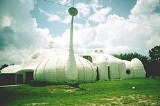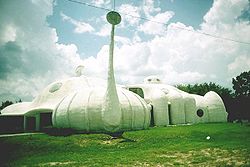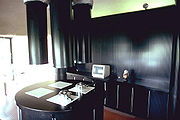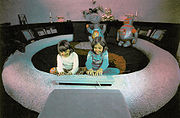
Xanadu House
Encyclopedia

Experimental home
An experimental home is a home with new design or function in order to improve living conditions....
s built to showcase examples of computer
Computer
A computer is a programmable machine designed to sequentially and automatically carry out a sequence of arithmetic or logical operations. The particular sequence of operations can be changed readily, allowing the computer to solve more than one kind of problem...
s and automation
Automation
Automation is the use of control systems and information technologies to reduce the need for human work in the production of goods and services. In the scope of industrialization, automation is a step beyond mechanization...
in the home in the United States
United States
The United States of America is a federal constitutional republic comprising fifty states and a federal district...
. The architectural project began in 1979, and during the early 1980s three houses were built in different parts of the US: one each in Kissimmee
Kissimmee, Florida
Kissimmee is a city in Osceola County, Florida, United States. As of the 2010 census, the population was 59,682. It is the county seat of Osceola County...
, Florida
Florida
Florida is a state in the southeastern United States, located on the nation's Atlantic and Gulf coasts. It is bordered to the west by the Gulf of Mexico, to the north by Alabama and Georgia and to the east by the Atlantic Ocean. With a population of 18,801,310 as measured by the 2010 census, it...
; Wisconsin Dells
Wisconsin Dells, Wisconsin
Wisconsin Dells is a city in south-central Wisconsin, with a population of 2,418 as of the 2000 census. It straddles four counties: Adams, Columbia, Juneau, and Sauk. The city takes its name from the dells of the Wisconsin River, a scenic, glacially formed gorge that features striking sandstone...
, Wisconsin
Wisconsin
Wisconsin is a U.S. state located in the north-central United States and is part of the Midwest. It is bordered by Minnesota to the west, Iowa to the southwest, Illinois to the south, Lake Michigan to the east, Michigan to the northeast, and Lake Superior to the north. Wisconsin's capital is...
; and Gatlinburg
Gatlinburg, Tennessee
Gatlinburg is a mountain resort city in Sevier County, Tennessee, United States. As of the 2000 U.S. Census, Gatlinburg had a population of 3,828. The city is a popular vacation resort, as it rests on the border of the Great Smoky Mountains National Park along U.S...
, Tennessee
Tennessee
Tennessee is a U.S. state located in the Southeastern United States. It has a population of 6,346,105, making it the nation's 17th-largest state by population, and covers , making it the 36th-largest by total land area...
. The houses included novel construction and design techniques, and became popular tourist attraction
Tourist attraction
A tourist attraction is a place of interest where tourists visit, typically for its inherent or exhibited cultural value, historical significance, natural or built beauty, or amusement opportunities....
s during the 1980s.
The Xanadu Houses were notable for being built with polyurethane
Polyurethane
A polyurethane is any polymer composed of a chain of organic units joined by carbamate links. Polyurethane polymers are formed through step-growth polymerization, by reacting a monomer with another monomer in the presence of a catalyst.Polyurethanes are...
insulation foam rather than concrete
Concrete
Concrete is a composite construction material, composed of cement and other cementitious materials such as fly ash and slag cement, aggregate , water and chemical admixtures.The word concrete comes from the Latin word...
, for easy, fast, and cost-effective construction. They were ergonomically
Ergonomics
Ergonomics is the study of designing equipment and devices that fit the human body, its movements, and its cognitive abilities.The International Ergonomics Association defines ergonomics as follows:...
designed, and contained some of the earliest home automation
Home automation
Home automation is the residential extension of "building automation". It is automation of the home, housework or household activity. Home automation may include centralized control of lighting, HVAC , appliances, and other systems, to provide improved convenience, comfort, energy efficiency and...
systems. The Kissimmee Xanadu, designed by Roy Mason
Roy Mason (architect)
Roy Mason was a lecturer, writer, and futuristic architect who designed and built a variety of futuristic homes and other buildings in the 1970s and 1980s using low cost materials and alternative energy sources...
, was the most popular, and at its peak was attracting 1000 visitors every day. The Wisconsin Dells and Gatlinburg houses were closed and demolished in the early 1990s; the Kissimmee Xanadu House was closed in 1996 and demolished in October 2005.
Early development
Bob Masters was an early pioneer of houses built of rigid insulation. Before conceiving the Xanadu House concept, Masters designed and created inflatable balloons to be used in the construction of houses. He was inspired by architect Stan Nord Connolly's Kesinger House in DenverDenver, Colorado
The City and County of Denver is the capital and the most populous city of the U.S. state of Colorado. Denver is a consolidated city-county, located in the South Platte River Valley on the western edge of the High Plains just east of the Front Range of the Rocky Mountains...
, Colorado
Colorado
Colorado is a U.S. state that encompasses much of the Rocky Mountains as well as the northeastern portion of the Colorado Plateau and the western edge of the Great Plains...
, one of the earliest homes built from insulation. Masters built his first balloon-constructed house exterior in 1969 in less than three days during a turbulent snowstorm, using the same methods later used to build the Xanadu houses.
Masters was convinced that these dome-shaped homes built of foam could work for others, so he decided to create a series of show homes in the United States. Masters's business partner Tom Gussel chose the name "Xanadu" for the homes, a reference to Mongol Emperor Kublai Khan
Kublai Khan
Kublai Khan , born Kublai and also known by the temple name Shizu , was the fifth Great Khan of the Mongol Empire from 1260 to 1294 and the founder of the Yuan Dynasty in China...
's summer residence Xanadu
Xanadu
-Description of Xanadu by Toghon Temur :The lament of Toghon Temur Khan , concerning the loss of Daidu and Heibun Shanduu in 1368, is recorded in many Mongolian historical chronicles...
, which is prominently featured in Samuel Taylor Coleridge
Samuel Taylor Coleridge
Samuel Taylor Coleridge was an English poet, Romantic, literary critic and philosopher who, with his friend William Wordsworth, was a founder of the Romantic Movement in England and a member of the Lake Poets. He is probably best known for his poems The Rime of the Ancient Mariner and Kubla...
's famous poem Kubla Khan
Kubla Khan
Kubla Khan is a poem by Samuel Taylor Coleridge, completed in 1797 and published in Christabel, Kubla Khan, and the Pains of Sleep in 1816...
. The first Xanadu House opened in Wisconsin Dells
Wisconsin Dells, Wisconsin
Wisconsin Dells is a city in south-central Wisconsin, with a population of 2,418 as of the 2000 census. It straddles four counties: Adams, Columbia, Juneau, and Sauk. The city takes its name from the dells of the Wisconsin River, a scenic, glacially formed gorge that features striking sandstone...
, Wisconsin
Wisconsin
Wisconsin is a U.S. state located in the north-central United States and is part of the Midwest. It is bordered by Minnesota to the west, Iowa to the southwest, Illinois to the south, Lake Michigan to the east, Michigan to the northeast, and Lake Superior to the north. Wisconsin's capital is...
. It was designed by architect Stewart Gordon and constructed by Masters in 1979. It was 4000 square feet (371.6 m²) in area, and featured a geodesic greenhouse. 100,000 people visited the new attraction in its first summer.
Popularity
The most popular Xanadu house was the second house, designed by architect Roy MasonRoy Mason (architect)
Roy Mason was a lecturer, writer, and futuristic architect who designed and built a variety of futuristic homes and other buildings in the 1970s and 1980s using low cost materials and alternative energy sources...
. Masters met Mason in 1980 at a futures conference in Toronto
Toronto
Toronto is the provincial capital of Ontario and the largest city in Canada. It is located in Southern Ontario on the northwestern shore of Lake Ontario. A relatively modern city, Toronto's history dates back to the late-18th century, when its land was first purchased by the British monarchy from...
. Mason had worked on a similar project prior to his involvement in the creation of the Kissimmee Xanadu House — an “experimental school” on a hill in Virginia
Virginia
The Commonwealth of Virginia , is a U.S. state on the Atlantic Coast of the Southern United States. Virginia is nicknamed the "Old Dominion" and sometimes the "Mother of Presidents" after the eight U.S. presidents born there...
which was also a foam structure. Both Mason and Masters were influenced by other experimental houses and building concepts which emphasized ergonomics, usability, and energy efficiency. These included apartments designed by architect Kisho Kurokawa featuring detachable building modules and more significant designs including a floating habitat made of fiberglass designed by Jacques Beufs for living on water surfaces, concepts for living underwater by architect Jacques Rougerie and the Don Metz house built in the 1970s which took advantage of the earth as insulation. Fifty years before Xanadu House, another house from the 1933 Homes of Tomorrow Exhibition
1933 Homes of Tomorrow Exhibition
The Homes of Tomorrow Exhibition was part of the 1933 Chicago World's Fair. The Fair's theme that year was a Century of Progress, and celebrated man's innovations in architecture, science, technology and transportation...
at the Century of Progress
Century of Progress
A Century of Progress International Exposition was the name of a World's Fair held in Chicago from 1933 to 1934 to celebrate the city's centennial. The theme of the fair was technological innovation...
Exposition in Chicago introduced air conditioning, forced air heating, circuit breakers and electric eye doors.
Mason believed Xanadu House would alter people's views of houses as little more than inanimate, passive shelters against the elements. "No one's really looked at the house as a total organic system", said Mason, who was also the architecture editor of The Futurist magazine. "The house can have intelligence and each room can have intelligence." The estimated cost of construction for one home was $300,000. Roy Mason also planned a low cost version which would cost $80,000, to show that homes using computers do not have to be expensive. The low cost Xanadu was never built.
The Walt Disney Company
The Walt Disney Company
The Walt Disney Company is the largest media conglomerate in the world in terms of revenue. Founded on October 16, 1923, by Walt and Roy Disney as the Disney Brothers Cartoon Studio, Walt Disney Productions established itself as a leader in the American animation industry before diversifying into...
opened Epcot Center in Florida
Florida
Florida is a state in the southeastern United States, located on the nation's Atlantic and Gulf coasts. It is bordered to the west by the Gulf of Mexico, to the north by Alabama and Georgia and to the east by the Atlantic Ocean. With a population of 18,801,310 as measured by the 2010 census, it...
on October 1, 1982 (originally envisioned as the Experimental Prototype Community of Tomorrow
Experimental Prototype Community of Tomorrow (concept)
The Experimental Prototype Community of Tomorrow was a concept developed by Walt Disney near the end of his lifetime. This planned city was his intended purpose for the property purchased near Orlando, Florida, that eventually became the Walt Disney World Resort...
). Masters and Mason decided to open a Xanadu House several miles away in Kissimmee. It eventually opened in 1983, after several years of research into the concepts Xanadu would use. It was over 6000 square feet (557.4 m²) in size, considerably larger than the average house because it was built as a showcase. At its peak in the mid 1980s, more than 1,000 people visited the new Kissimmee attraction every day. A third Xanadu House was built in Gatlinburg, Tennessee. Shortly after the Xanadu Houses were built and opened as visitor attractions, tourism companies began to advertise them as the "home of the future" in brochures encouraging people to visit.
Demise
By the early 1990s, the Xanadu houses began to lose popularity because the technology they used was quickly becoming obsolete, and as a result the houses in Wisconsin and Tennessee were demolished, while the Xanadu House in Kissimmee continued to operate as a public visitor attraction until it was closed in 1996. It was consequently put up for sale in 1997 and was sold for office and storage use. By 2001 the Kissimmee house had suffered greatly from mold and mildew throughout the interior due to a lack of maintenance since being used as a visitor attraction, it was put up for sale again for an asking price of US$2 million. By October 2005, the last of the Xanadu houses had been demolished, following years of abandonment and use by the homeless. The Kissimmee house was also featured in the 2007 movie "Urban Explorers: Into the Darkness". It showed the house in disrepair with doors wide open, mold growing everywhere and a homeless man living inside. The "explorers" walked through the house filming the decay firsthand as the homeless man slept in a chair on the main floor. At the end of the segment, the man wakes up and threatens the "explorers" telling them to leave "his home"!Construction
Construction of the Xanadu house in Kissimmee, FloridaKissimmee, Florida
Kissimmee is a city in Osceola County, Florida, United States. As of the 2010 census, the population was 59,682. It is the county seat of Osceola County...
, began with the pouring of a concrete slab base and the erection of a tension ring 40 feet (12.2 m) in diameter to anchor the domed roof of what would become the "Great Room" of the house. A pre-shaped vinyl balloon was formed and attached to the ring, and then inflated by air pressure from large fans. Once the form was fully inflated, its interior surface was sprayed with quick-hardening polyurethane plastic foam. Spraying from the inside permitted work to continue even in wet or windy weather. The foam, produced by the sudden mixture of two chemicals that expand on contact to 30 times their original volume, hardened almost instantly. Repeated spraying produced a five-to-six-inch-thick structurally sound shell within a few hours. Once the foam cured, the plastic balloon form was removed to be used again. Once the second dome was completed and the balloon form removed, the two rooms were joined together by wire mesh which was also sprayed with foam to form a connecting gallery or hall. This process was repeated until the house was complete. Window, skylight, and door openings were cut and the frames foamed into place. Finally, the interior of the entire structure was sprayed with a 3/4 inch (1.9 cm) coating of fireproof material that also provided a smooth, easy-to-clean finish for walls and ceilings. The exterior was given a coat of white elastomeric paint as the final touch.
Interior

The Xanadu house in Kissimmee, Florida used an automated
Automation
Automation is the use of control systems and information technologies to reduce the need for human work in the production of goods and services. In the scope of industrialization, automation is a step beyond mechanization...
system controlled by Commodore
Commodore International
Commodore is the commonly used name for Commodore Business Machines , the U.S.-based home computer manufacturer and electronics manufacturer headquartered in West Chester, Pennsylvania, which also housed Commodore's corporate parent company, Commodore International Limited...
microcomputer
Microcomputer
A microcomputer is a computer with a microprocessor as its central processing unit. They are physically small compared to mainframe and minicomputers...
s. The house had fifteen rooms; of these the kitchen, party room, health spa, and bedrooms all used computers and other electronic equipment heavily in their design. The automation concepts which Xanadu House used are based on original ideas conceived in the 1950s and earlier. The Xanadu Houses aimed to bring the original concepts into a finished and working implementation. Visitors followed an electronic tour guide
Tour guide
A tour guide provides assistance, information and cultural, historical and contemporary heritage interpretation to people on organized tours, individual clients, educational establishments, at religious and historical sites, museums, and at venues of other significant interest...
of the house, featuring constantly changing computer-graphics art displayed on video screens in the family room. Through the guide, visitors learned about the different advantages and features of the house including the security and fire systems.

Fountain
A fountain is a piece of architecture which pours water into a basin or jets it into the air either to supply drinking water or for decorative or dramatic effect....
, small television set, and a video projector
Video projector
A video projector is an image projector that receives a video signal and projects the corresponding image on a projection screen using a lens system. All video projectors use a very bright light to project the image, and most modern ones can correct any curves, blurriness, and other...
. Nearby was the dining room, featuring a glass table with a curved seat surrounding it; behind the seats was a large window covering
Window covering
Window coverings are material used to cover a window to manage sunlight, to provide additional weatherproofing, to ensure privacy or for purely decorative purposes....
the entire wall. The family room featured television monitors and other electronic
Electronics
Electronics is the branch of science, engineering and technology that deals with electrical circuits involving active electrical components such as vacuum tubes, transistors, diodes and integrated circuits, and associated passive interconnection technologies...
equipment covering the walls. The builders called the entertainment center
Entertainment center
A home entertainment center is a piece of furniture seen in many homes in North America, which houses major electronic items, such as a television set, a VCR and/or DVD player, stereo components , and cable or satellite television receivers...
an "electronic hearth". It was planned as a gathering place for family members and relatives, just as is a traditional hearth with a fireplace
Fireplace
A fireplace is an architectural structure to contain a fire for heating and, especially historically, for cooking. A fire is contained in a firebox or firepit; a chimney or other flue allows gas and particulate exhaust to escape...
.
The kitchen was automated by "autochef", an electronic dietitian which planned well-balanced meals. Meals could be cooked automatically at a set date and time. If new food was required, it could either be obtained via tele-shopping through the computer system or from Xanadu's own greenhouse. The kitchen's computer terminal could also be used for the household calendar, records, and home book keeping.
The Xanadu homes also suggested a way to do business
Business
A business is an organization engaged in the trade of goods, services, or both to consumers. Businesses are predominant in capitalist economies, where most of them are privately owned and administered to earn profit to increase the wealth of their owners. Businesses may also be not-for-profit...
at home with the office
Office
An office is generally a room or other area in which people work, but may also denote a position within an organization with specific duties attached to it ; the latter is in fact an earlier usage, office as place originally referring to the location of one's duty. When used as an adjective, the...
room and the use of computers for electronic mail, access to stock and commodities trading, and news services.

In the spa, people could relax in a whirlpool, sun sauna, and environmentally-controlled habitat, and exercise with the assistance of spa monitors. One of the advantages of using computers in the home includes security. In Xanadu House, a HAL
HAL 9000
HAL 9000 is the antagonist in Arthur C. Clarke's science fiction Space Odyssey saga. HAL is an artificial intelligence that interacts with the astronaut crew of the Discovery One spacecraft, usually represented as a red television-camera eye found throughout the ship...
-type voice spoke when someone entered to make the intruder think someone was home.
Disadvantages
An initial concern was that electricity costs would be excessive, since several computers would be operating continuously. Mason figured that a central computer could control the energy consumption of all the other computers in the house. Many believed using computers in the home was a disadvantage, because of the possibility of equipment failure, occupants would be restricted from getting food, having a bath, and even leaving the house if doors were locked. Many also resisted the concept of computers in the home because of concerns people would become less social. Those in favor argued that computers improved security and helped get household chores such as cleaning done quickly.While the majority of people who visited a Xanadu House felt at ease because of the organic design, others felt that the concept was not viable because it was badly affected by the weather. Other architects and designers saw Xanadu House as an unprofessional architectural design because of the materials used, and the odd use of colors and shapes inside the home. Designers continued to build conventionally-shaped homes, dismissing Xanadu House as an unsuccessful concept. Many disliked Xanadu House as a practical home because of its low ceilings, curved walls, and cramped rooms.

